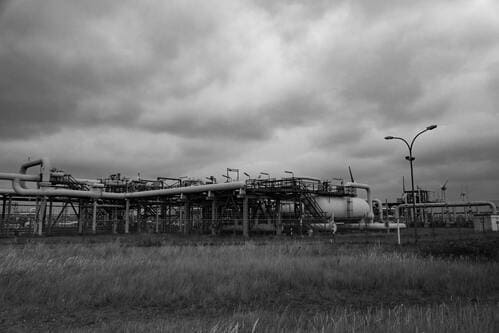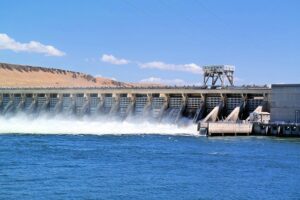We have already published a range of articles referring to different applications of fiber optic technology in various industries and fields. Geophysics has also applied distributed sensing as a powerful instrument for structural health monitoring, such in, the oil and gas industry, tunnel safety monitoring, etc.
Seismic monitoring has been no exception. Resistance to electromagnetic disturbance, cost-effectiveness and possibility of implementing into hard-to-reach regions or places that can be harmful for human health are undeniable advantages of distributed sensing systems.
What is Distributed Sensing Technology?
Distributed sensing is a technology that provides continuous measurements in real-time. Compared to traditional sensors, placed at certain points, distributed sensing acts as a sensing element along its entire length because the whole fiber optic cable is applied.
Due to the exploitation of the entire fiber optic cable all over its length, this method is considered to be one of the most cost-effective tools that can be placed in severe conditions.
Operation Principle of the Distributed Sensing Systems
In simpler terms, DAS systems as a part of the distributed sensing technology consist of several components including fiber optic cable and an attached optoelectronic device – FBG interrogator. The interrogator sends short pulses of the pulsed laser light into fiber optic cable. Then the backscattered light moves back up the fiber to the FBG interrogation unit. Due to the time that the laser pulse takes, there can be found the relation backscatter event and a fiber distance.
The FBG interrogator is connected to a processing unit that processes and stores the received data. This unit gets the raw data and transfers it into the information that is displayed in the program.
The software provides the visualized analysis that includes the previous data as well. In case there are any differences, fiber optic system alarms specialists. For instance, the system can display the location of the fiber optic cable on the map and highlight locations where the rates have changed or exceeded acceptable limits.
What’s the Difference Between DAS and DTS Systems?
Traditionally, distributed sensing systems are divided into distributed temperature sensing and distributed acoustic sensing.
The main difference between DTS and DAS systems is the type of signals they get to provide analysis. DTS systems are sensitive to temperature changes, while DAS is sensitive to acoustic vibrations. Therefore, their operation principle is also different. Due to the fiber qualities, the performance of DTS systems is able to stay at the necessary high injected pump power level. At the same time, DAS systems don’t require such high pump power as DTS systems because of the Rayleigh scattering.
DAS Systems and Their Applications in Seismic Monitoring
If we are talking about seismic monitoring, distributed acoustic sensing is used. DAS systems measure any vibrations that can’t be detected by DTS technology.
The goal of all seismic monitoring systems is warning before any accident occurs. Their effectiveness depends on the accuracy of the obtained data, lifetime and length. That’s why there is a necessity in a continuous operating system that is capable of working in severe environments and over long distances.
DAS systems were implemented as seismic monitoring systems due to the above-mentioned advantages as well as low cost, no special maintenance, robustness, etc. Therefore, distributed acoustic systems have provided new capabilities for seismic monitoring.
Field Projects Where Sensing Systems Were Applied
If we are talking about sensing systems, in most cases fiber optic sensors were more effective in comparison with the conventional electronic ones. That provides unrivaled performance, especially in critical applications.
For example, two years ago the specialists started a range of experiments in the Arctic and the Arctic Ocean. This is the first case when DAS systems were installed in the Arctic. Scientists wanted to get the analysis of the seafloor seismic activities and other processes under Arctic sea ice with a distributed acoustic sensing system. Fiber optic cable catches the vibrations about all the changes of the ocean 24/7.
The other project with DAS systems has also allowed scientists to see them in other severe environmental conditions. Since they are installed mostly in the ground, specialists have monitored their performance in snow. The most concerning parameters for them were the snow depth and severe frosts.
Finally, in the conditions of decreasing temperatures the reduction in background noise and better signal-to-noise ratio was noticed. In fact, the lower temperatures, the better results distributed acoustic sensing has provided. Cold temperatures don’t make fiber optic performance difficult or interfere with accuracy of the received data. Moreover, fiber optic cable is able to transfer signals at snow depths of at least 0.65m.
Distributed sensing as a tool for seismic monitoring systems has proved to be effective in detection of any seismic shocks and flow changes. All in all, DAS provides capabilities for seismic monitoring of the near surface.
Optromix is a fast-growing vendor of fiber Bragg grating (FBG) product line such as fiber Bragg grating sensors, for example, FBG strain sensors, FBG interrogators and multiplexers, Distributed Acoustic Sensing (DAS) systems, Distributed Temperature Sensing (DTS) systems. The company creates and supplies a broad variety of fiber optic solutions for monitoring worldwide. If you are interested in structural health monitoring systems and want to learn more, please contact us at info@optromix.com






 Special fiber optic technology can make fiber optic cable a sensing one. That solves many challenges including monitoring long units like pipelines, tunnels, or power cables. With the help of fiber optic sensors, it is more likely to find the leak in a short time. FBG interrogator sends a laser pulse through the fiber optic cable and the light comes back to the interrogator. The back scattered light delivers back acoustic, vibration, and thermal data.
Special fiber optic technology can make fiber optic cable a sensing one. That solves many challenges including monitoring long units like pipelines, tunnels, or power cables. With the help of fiber optic sensors, it is more likely to find the leak in a short time. FBG interrogator sends a laser pulse through the fiber optic cable and the light comes back to the interrogator. The back scattered light delivers back acoustic, vibration, and thermal data. Almost all pipelines suffer from numerous leaks during their operation, therefore, they require systems for
Almost all pipelines suffer from numerous leaks during their operation, therefore, they require systems for Dams applied for hydropower, irrigation or mining play a crucial role in human life, herewith, they evoke significant human, economic, and environmental consequences when they fail. Nevertheless,
Dams applied for hydropower, irrigation or mining play a crucial role in human life, herewith, they evoke significant human, economic, and environmental consequences when they fail. Nevertheless,